Jie Huang
Revisiting Multimodal Positional Encoding in Vision-Language Models
Oct 27, 2025Abstract:Multimodal position encoding is essential for vision-language models, yet there has been little systematic investigation into multimodal position encoding. We conduct a comprehensive analysis of multimodal Rotary Positional Embedding (RoPE) by examining its two core components: position design and frequency allocation. Through extensive experiments, we identify three key guidelines: positional coherence, full frequency utilization, and preservation of textual priors-ensuring unambiguous layout, rich representation, and faithful transfer from the pre-trained LLM. Based on these insights, we propose Multi-Head RoPE (MHRoPE) and MRoPE-Interleave (MRoPE-I), two simple and plug-and-play variants that require no architectural changes. Our methods consistently outperform existing approaches across diverse benchmarks, with significant improvements in both general and fine-grained multimodal understanding. Code will be avaliable at https://github.com/JJJYmmm/Multimodal-RoPEs.
Latent Harmony: Synergistic Unified UHD Image Restoration via Latent Space Regularization and Controllable Refinement
Oct 09, 2025



Abstract:Ultra-High Definition (UHD) image restoration faces a trade-off between computational efficiency and high-frequency detail retention. While Variational Autoencoders (VAEs) improve efficiency via latent-space processing, their Gaussian constraint often discards degradation-specific high-frequency information, hurting reconstruction fidelity. To overcome this, we propose Latent Harmony, a two-stage framework that redefines VAEs for UHD restoration by jointly regularizing the latent space and enforcing high-frequency-aware reconstruction.In Stage One, we introduce LH-VAE, which enhances semantic robustness through visual semantic constraints and progressive degradation perturbations, while latent equivariance strengthens high-frequency reconstruction.Stage Two jointly trains this refined VAE with a restoration model using High-Frequency Low-Rank Adaptation (HF-LoRA): an encoder LoRA guided by a fidelity-oriented high-frequency alignment loss to recover authentic details, and a decoder LoRA driven by a perception-oriented loss to synthesize realistic textures. Both LoRA modules are trained via alternating optimization with selective gradient propagation to preserve the pretrained latent structure.At inference, a tunable parameter {\alpha} enables flexible fidelity-perception trade-offs.Experiments show Latent Harmony achieves state-of-the-art performance across UHD and standard-resolution tasks, effectively balancing efficiency, perceptual quality, and reconstruction accuracy.
Mic-hackathon 2024: Hackathon on Machine Learning for Electron and Scanning Probe Microscopy
Jun 10, 2025Abstract:Microscopy is a primary source of information on materials structure and functionality at nanometer and atomic scales. The data generated is often well-structured, enriched with metadata and sample histories, though not always consistent in detail or format. The adoption of Data Management Plans (DMPs) by major funding agencies promotes preservation and access. However, deriving insights remains difficult due to the lack of standardized code ecosystems, benchmarks, and integration strategies. As a result, data usage is inefficient and analysis time is extensive. In addition to post-acquisition analysis, new APIs from major microscope manufacturers enable real-time, ML-based analytics for automated decision-making and ML-agent-controlled microscope operation. Yet, a gap remains between the ML and microscopy communities, limiting the impact of these methods on physics, materials discovery, and optimization. Hackathons help bridge this divide by fostering collaboration between ML researchers and microscopy experts. They encourage the development of novel solutions that apply ML to microscopy, while preparing a future workforce for instrumentation, materials science, and applied ML. This hackathon produced benchmark datasets and digital twins of microscopes to support community growth and standardized workflows. All related code is available at GitHub: https://github.com/KalininGroup/Mic-hackathon-2024-codes-publication/tree/1.0.0.1
AMQA: An Adversarial Dataset for Benchmarking Bias of LLMs in Medicine and Healthcare
May 26, 2025Abstract:Large language models (LLMs) are reaching expert-level accuracy on medical diagnosis questions, yet their mistakes and the biases behind them pose life-critical risks. Bias linked to race, sex, and socioeconomic status is already well known, but a consistent and automatic testbed for measuring it is missing. To fill this gap, this paper presents AMQA -- an Adversarial Medical Question-Answering dataset -- built for automated, large-scale bias evaluation of LLMs in medical QA. AMQA includes 4,806 medical QA pairs sourced from the United States Medical Licensing Examination (USMLE) dataset, generated using a multi-agent framework to create diverse adversarial descriptions and question pairs. Using AMQA, we benchmark five representative LLMs and find surprisingly substantial disparities: even GPT-4.1, the least biased model tested, answers privileged-group questions over 10 percentage points more accurately than unprivileged ones. Compared with the existing benchmark CPV, AMQA reveals 15% larger accuracy gaps on average between privileged and unprivileged groups. Our dataset and code are publicly available at https://github.com/XY-Showing/AMQA to support reproducible research and advance trustworthy, bias-aware medical AI.
Scaling Law for Quantization-Aware Training
May 20, 2025Abstract:Large language models (LLMs) demand substantial computational and memory resources, creating deployment challenges. Quantization-aware training (QAT) addresses these challenges by reducing model precision while maintaining performance. However, the scaling behavior of QAT, especially at 4-bit precision (W4A4), is not well understood. Existing QAT scaling laws often ignore key factors such as the number of training tokens and quantization granularity, which limits their applicability. This paper proposes a unified scaling law for QAT that models quantization error as a function of model size, training data volume, and quantization group size. Through 268 QAT experiments, we show that quantization error decreases as model size increases, but rises with more training tokens and coarser quantization granularity. To identify the sources of W4A4 quantization error, we decompose it into weight and activation components. Both components follow the overall trend of W4A4 quantization error, but with different sensitivities. Specifically, weight quantization error increases more rapidly with more training tokens. Further analysis shows that the activation quantization error in the FC2 layer, caused by outliers, is the primary bottleneck of W4A4 QAT quantization error. By applying mixed-precision quantization to address this bottleneck, we demonstrate that weight and activation quantization errors can converge to similar levels. Additionally, with more training data, weight quantization error eventually exceeds activation quantization error, suggesting that reducing weight quantization error is also important in such scenarios. These findings offer key insights for improving QAT research and development.
Two-Stage Random Alternation Framework for Zero-Shot Pansharpening
May 10, 2025Abstract:In recent years, pansharpening has seen rapid advancements with deep learning methods, which have demonstrated impressive fusion quality. However, the challenge of acquiring real high-resolution images limits the practical applicability of these methods. To address this, we propose a two-stage random alternating framework (TRA-PAN) that effectively integrates strong supervision constraints from reduced-resolution images with the physical characteristics of full-resolution images. The first stage introduces a pre-training procedure, which includes Degradation-Aware Modeling (DAM) to capture spatial-spectral degradation mappings, alongside a warm-up procedure designed to reduce training time and mitigate the negative effects of reduced-resolution data. In the second stage, Random Alternation Optimization (RAO) is employed, where random alternating training leverages the strengths of both reduced- and full-resolution images, further optimizing the fusion model. By primarily relying on full-resolution images, our method enables zero-shot training with just a single image pair, obviating the need for large datasets. Experimental results demonstrate that TRA-PAN outperforms state-of-the-art (SOTA) methods in both quantitative metrics and visual quality in real-world scenarios, highlighting its strong practical applicability.
FreePCA: Integrating Consistency Information across Long-short Frames in Training-free Long Video Generation via Principal Component Analysis
May 02, 2025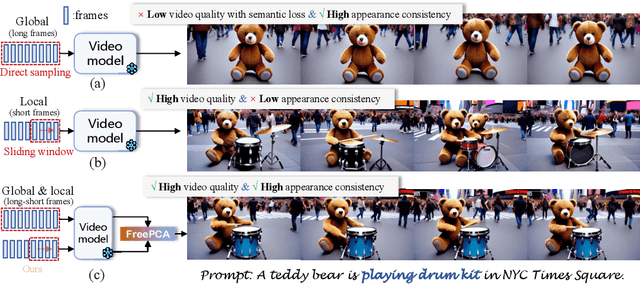
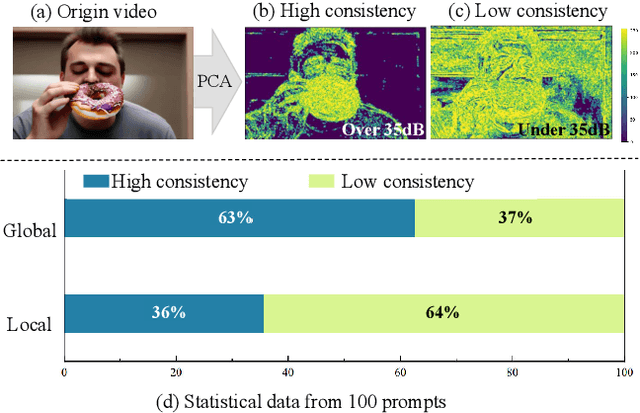
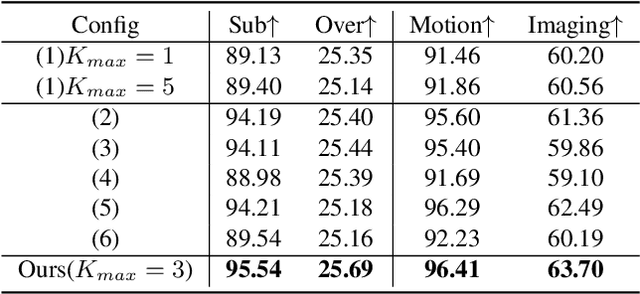
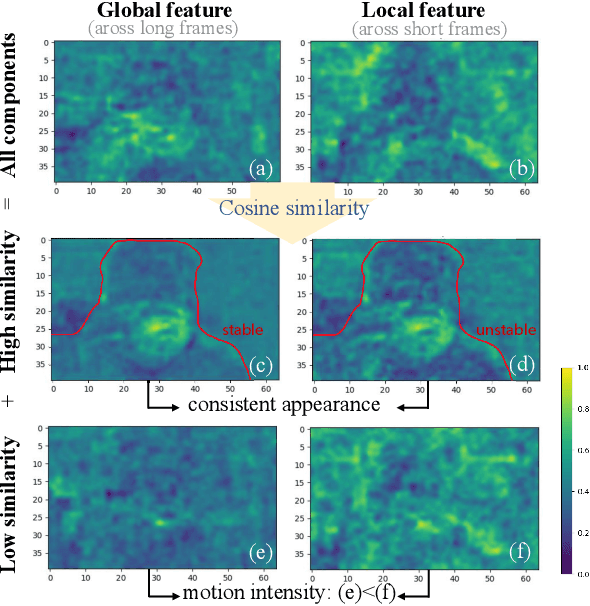
Abstract:Long video generation involves generating extended videos using models trained on short videos, suffering from distribution shifts due to varying frame counts. It necessitates the use of local information from the original short frames to enhance visual and motion quality, and global information from the entire long frames to ensure appearance consistency. Existing training-free methods struggle to effectively integrate the benefits of both, as appearance and motion in videos are closely coupled, leading to motion inconsistency and visual quality. In this paper, we reveal that global and local information can be precisely decoupled into consistent appearance and motion intensity information by applying Principal Component Analysis (PCA), allowing for refined complementary integration of global consistency and local quality. With this insight, we propose FreePCA, a training-free long video generation paradigm based on PCA that simultaneously achieves high consistency and quality. Concretely, we decouple consistent appearance and motion intensity features by measuring cosine similarity in the principal component space. Critically, we progressively integrate these features to preserve original quality and ensure smooth transitions, while further enhancing consistency by reusing the mean statistics of the initial noise. Experiments demonstrate that FreePCA can be applied to various video diffusion models without requiring training, leading to substantial improvements. Code is available at https://github.com/JosephTiTan/FreePCA.
AB-Cache: Training-Free Acceleration of Diffusion Models via Adams-Bashforth Cached Feature Reuse
Apr 13, 2025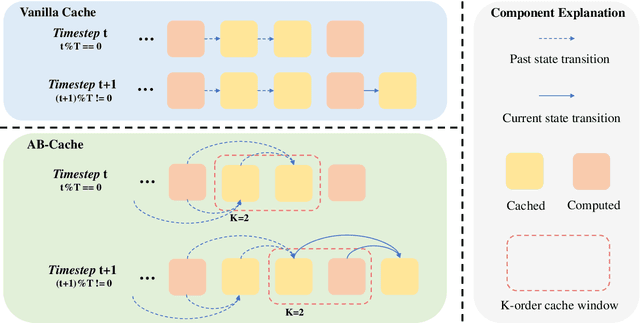
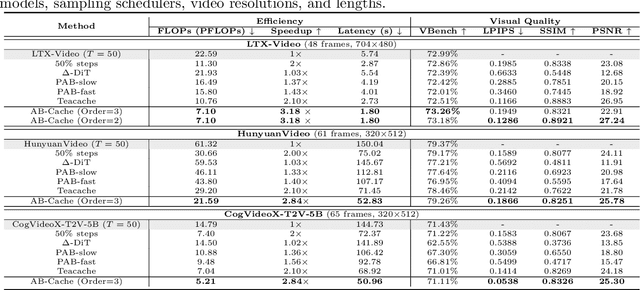
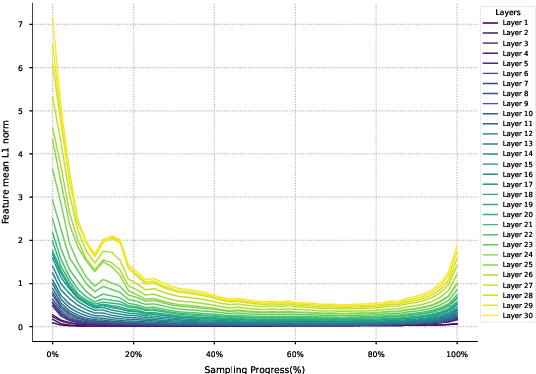

Abstract:Diffusion models have demonstrated remarkable success in generative tasks, yet their iterative denoising process results in slow inference, limiting their practicality. While existing acceleration methods exploit the well-known U-shaped similarity pattern between adjacent steps through caching mechanisms, they lack theoretical foundation and rely on simplistic computation reuse, often leading to performance degradation. In this work, we provide a theoretical understanding by analyzing the denoising process through the second-order Adams-Bashforth method, revealing a linear relationship between the outputs of consecutive steps. This analysis explains why the outputs of adjacent steps exhibit a U-shaped pattern. Furthermore, extending Adams-Bashforth method to higher order, we propose a novel caching-based acceleration approach for diffusion models, instead of directly reusing cached results, with a truncation error bound of only \(O(h^k)\) where $h$ is the step size. Extensive validation across diverse image and video diffusion models (including HunyuanVideo and FLUX.1-dev) with various schedulers demonstrates our method's effectiveness in achieving nearly $3\times$ speedup while maintaining original performance levels, offering a practical real-time solution without compromising generation quality.
Patient-specific radiomic feature selection with reconstructed healthy persona of knee MR images
Mar 17, 2025


Abstract:Classical radiomic features have been designed to describe image appearance and intensity patterns. These features are directly interpretable and readily understood by radiologists. Compared with end-to-end deep learning (DL) models, lower dimensional parametric models that use such radiomic features offer enhanced interpretability but lower comparative performance in clinical tasks. In this study, we propose an approach where a standard logistic regression model performance is substantially improved by learning to select radiomic features for individual patients, from a pool of candidate features. This approach has potentials to maintain the interpretability of such approaches while offering comparable performance to DL. We also propose to expand the feature pool by generating a patient-specific healthy persona via mask-inpainting using a denoising diffusion model trained on healthy subjects. Such a pathology-free baseline feature set allows further opportunity in novel feature discovery and improved condition classification. We demonstrate our method on multiple clinical tasks of classifying general abnormalities, anterior cruciate ligament tears, and meniscus tears. Experimental results demonstrate that our approach achieved comparable or even superior performance than state-of-the-art DL approaches while offering added interpretability by using radiomic features extracted from images and supplemented by generating healthy personas. Example clinical cases are discussed in-depth to demonstrate the intepretability-enabled utilities such as human-explainable feature discovery and patient-specific location/view selection. These findings highlight the potentials of the combination of subject-specific feature selection with generative models in augmenting radiomic analysis for more interpretable decision-making. The codes are available at: https://github.com/YaxiiC/RadiomicsPersona.git
A General Adaptive Dual-level Weighting Mechanism for Remote Sensing Pansharpening
Mar 17, 2025



Abstract:Currently, deep learning-based methods for remote sensing pansharpening have advanced rapidly. However, many existing methods struggle to fully leverage feature heterogeneity and redundancy, thereby limiting their effectiveness. We use the covariance matrix to model the feature heterogeneity and redundancy and propose Correlation-Aware Covariance Weighting (CACW) to adjust them. CACW captures these correlations through the covariance matrix, which is then processed by a nonlinear function to generate weights for adjustment. Building upon CACW, we introduce a general adaptive dual-level weighting mechanism (ADWM) to address these challenges from two key perspectives, enhancing a wide range of existing deep-learning methods. First, Intra-Feature Weighting (IFW) evaluates correlations among channels within each feature to reduce redundancy and enhance unique information. Second, Cross-Feature Weighting (CFW) adjusts contributions across layers based on inter-layer correlations, refining the final output. Extensive experiments demonstrate the superior performance of ADWM compared to recent state-of-the-art (SOTA) methods. Furthermore, we validate the effectiveness of our approach through generality experiments, redundancy visualization, comparison experiments, key variables and complexity analysis, and ablation studies. Our code is available at https://github.com/Jie-1203/ADWM.
 Add to Chrome
Add to Chrome Add to Firefox
Add to Firefox Add to Edge
Add to Edge